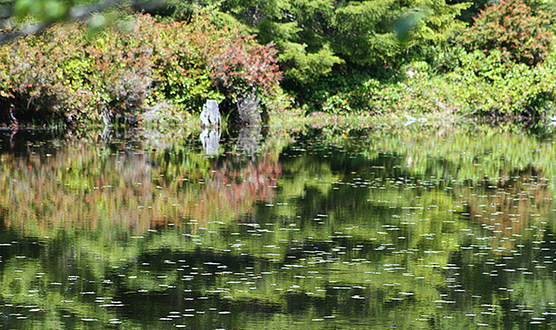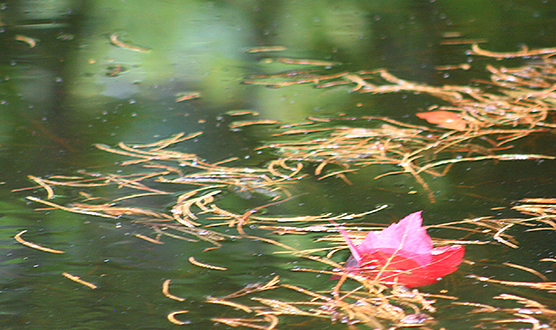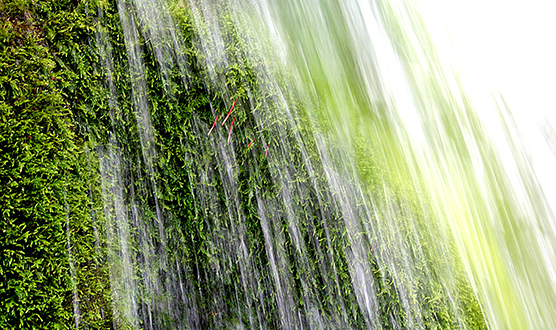Circulating
Blessings
This is the blessing time,
let us be whole
and free.
The fruit of resting in silent awareness is direct experience of heart, an encounter that is sometimes called a “blessing.” According to Benedictine monk, David Steindl-Rast, a blessing is simply the flow of divine energy inside a person or within and between two or more persons. This kind of spiritual experience may include, but does not require, the presence of an authority figure, such as a priest or a guru.
Blessings can occur when and wherever individuals sincerely open themselves to the divine: while lounging with a friend under a spreading tree, sipping tea alone in a busy cafe, scaling a cliff fifty feet high, taking notes in a college math class, or singing hymns with a chapel choir.*
During spontaneous meditation sessions, we intentionally open to the fount of spiritual energy that resides in our core—to, that is, the interior source of blessings. When we feel this inner force quicken, we allow it to move within and between us—an action that can join ego (the conditioned self) to essence (the unconditioned self) and person to person. Spontaneous meditation is relational. It happens “between” and “among.”
When love flows freely inside a person, it is able to connect parts of the personality with the essential, divine self. When two persons welcome this interior flow, heart’s energy moves first within each individual, then circulates between them. In a group, spiritual energy may travel among members, uniting three or more in love.
Heart’s Refreshing Pool
In Hebrew, “blessing” is related to the word “pool,” the life-giving water found in the desert. Like an oasis, blessing refreshes and renews. When I receive blessings directly from heart, I often feel I’m being bathed in a loving presence, although the specific body sensations I’ve experienced have changed with time. In the beginning, this presence felt like an effervescent current, rushing inside me. Later, as this current quieted down, it left me in a shimmering, silent spring.
Still later, I knew divine love was present when spiritual energy surged in my palms, tendrils of light rose in my brow or a wild geyser shot upward in my body, overflowing at my chest or in my head. These days, the holy force enfolds me in a soothing, luminous mist—or takes me into a vast, liberating consciousness.
Whatever sensations arise, contact with heart usually blesses me with calmness and energy, relieving me, at least temporarily, of everyday worries and stresses. While I am immersed in this life-giving substance, the limitations and biases of my personality often loosen, allowing insights into problems to emerge.
Heart’s love-force, then, is capable of transforming known symptoms like tiredness or confusion; sometimes it reveals hidden talents and abilities, too. The history of religions is filled with stories of the talents that emerge through direct contact with heart: the ability to commune with wild animals, to sense subtle smells or sounds, to write pages of exquisite spiritual poetry in a day, to bring harmony into situations of intense conflict, or to delve deeply into the essential workings of the universe.
Direct encounters with heart can also lead ordinary people into mystical experiences they never thought possible—into awareness of the oneness of all living creatures, for example, or of the holy light that dwells deep inside each person.
The Dancing Gift
Among the most surprising mystical experiences I’ve received from heart are its spontaneous movements, called “The Dancing Gift” by the New England Shakers. The fact that a power not originating in my individual will dwells inside me—and also prompts me into gestures and vocalizations of its own choosing—is startling enough, but when these movements and sounds assume forms that are both beautiful and symbolic, I am truly amazed.
I first experienced heart’s symbolic gestures in the spring of 1981. My record of the transition from shaking movements to graceful ones reads as follows:
Today, the river of love begins by guiding me into familiar experiences: my body shakes and my hands flap and spin. Then, suddenly, the current quiets my shaking hands and moves them together, so that my open palms face the floor, and my index fingers touch along the sides. Then it rotates both hands at the wrists while simultaneously raising them upward, until they are above my head. Still rotating my hands, it then returns them both to my lap. The river repeats this gesture many times.
I find this movement beautiful and wonder if it has a meaning. Asking with a silent thought, I hear, “I wash myself in the love of God.” How perfectly these words fit this gesture! My rotating hands look as if they are washing and my arms, traveling between my head and my lap, connect “the above” with “the below.”
During my next meditation, I discover that most of the chaotic movements— my shaking body and my flapping and spinning hands—have disappeared. In their place are graceful, dance-like gestures, located in my upper body. Most come and go quickly. However, a few repeat many times so I ask if they have a meaning. When my body rocks gently front to back while I am seated, I hear, “I say ‘yes’ to life.” When my hands cross at the wrists then undulate like bird wings, I hear, “I take flight in God.” When both my head and arms stretch backward, opening my chest, I hear, “Love is my birthright.”
I watch with delight as my body becomes the vehicle for these lovely and wise gestures. Intrigued by what I see and feel, I wonder: does every human body carry deep within it a kinesthetic code whose message is love?
When these gestures first emerged, I did not associate them with any particular tradition, but within a few months I began experiencing movement patterns found in several religions. I recorded these early discoveries in three short paragraphs:
It is now the summer of 1981 and I am five months into this spiritual awakening. These days, the river of love leads me into full-body, dance-like movements—not just the hand gestures of a few months ago. Although many are unfamiliar to me, I recognize several. Hatha yoga asanas regularly appear, postures such as the “cobra,” the “boat,” and the “salute to the sun.” Sometimes I sway and undulate like a Polynesian dancer; other times I glide like a tai chi practitioner. Often, I twirl like a dervish.
Recently, I learned that the Shakers of eighteenth-century New England experienced flapping movements during their silent worship services similar to those I enacted just a few months ago. When their hands waved back and forth with palms downward, they believed they were shaking out the carnal. When their hands fluttered with palms upward, they said they were entreating the Spirit.
Watching the spiritual practices of remote cultures appear spontaneously through the medium of my own body, I am filled with wonder.
From the beginning, heart also prompted me into spontaneous vocalizations. I trilled like a flute and toned like a “singing” bowl, for example, but I did not associate my sounds with any particular culture. By the mid-1980’s, however, the sounds were becoming more varied and more frequent and I began identifying them with distinct traditions. I droned like a Tibetan monk, made bird calls like a shaman in trance and chanted like a Native American healer.
In 1991, while reading about the Indian sage, Anandamayi Ma, I learned that I was not the only person who spontaneously performed the movements and sounds of various religious traditions when my mind was quiet. She reported that during a six-year period her body, guided by a holy inner power, spontaneously enacted the movements and vocal practices of countless religious lineages.
Through these experiences and others, I hypothesized that heart—the Indwelling God—originated many body-based spiritual disciplines now taught in the world’s religions. These practices began, I suspect, when seekers opened to heart’s all-knowing stream and allowed it to guide them into movements and vocal experiences. Only later were these practices codified and taught as techniques. In 1997, when Meditation Revolution (a compendium of writings on Siddha Yoga) was published, I discovered that Swami Muktananda and his followers had come to this same conclusion.
![]() Renewing through Gestures of Blessing
Renewing through Gestures of Blessing
Whether or not I’m able to link heart’s visible and audible blessings with a particular religious tradition, they often assume forms that seem tailor-made for me at any point in time. Once, when the energy spun me while my hands flew into various poses, my low-back pain mysteriously disappeared. Another time, when vocal sounds resembling the chants of Tibetan monks emerged, a sense of sluggishness lifted. Finger gestures, reminiscent of Hindu mudras, eased the discomfort in my hands from a repetitive stress injury.
Because my needs change from day to day, the poses and vocalizations I receive from heart usually vary from one meditation to the next. When other spontaneous meditators are present in the same room, their movements and sounds often assume distinct and individual forms, choreographed uniquely for them by heart’s wisdom.**
Over time, I also discovered, much to my surprise, that my vocal and dance-like expressions sometimes ministered to others. When I allowed my experiences to happen in the presence of receptive individuals, some reported benefiting from them. Most often, these encounters took place privately in one-on-one meetings or small groups. Occasionally, I performed before crowds of strangers. Individuals of various ages and backgrounds shared that they felt soothed, relieved, enlivened, inspired, liberated or awakened during our times together.
Through these experiences, I learned that I was not the only one blessed by heart’s spontaneous expressions. Heart’s love-light, made visible and audible through movements and sounds of its own design, sometimes blessed meditation partners and onlookers, too.
One day during meditation, I asked heart’s streaming force, “Why do you move me around so?” It answered simply, “So that others may see me.” I understood, then, that when I allowed this interior stream to “dance” and “sing” me in the presence of others, I was serving heart, enabling something of its mysterious love to be seen and heard.
Washing in Love’s River
Most of the time, I experienced heart’s “dancing gift” as a beautiful blessing, but sometimes it brought disturbing experiences, too. On the first night of my awakening, I watched divine love make visible a wounded aspect of myself that I’d never met directly before. I recorded this experience as follows:
While I lie on my back, spiritual energy keeps flowing inside me, causing my body to tremble and shake. Suddenly it slows my hands, leaving them bobbing up and down in mid-air; at the same time, it bends my legs up and inward. Just as I realize I’ve assumed an infant-like posture, the energy overflows at my mouth, pulling sounds from me as it goes. I gurgle, coo and suck like a contented baby. Then, with my legs still bent in the same position, the love-stream stretches my arms up toward the ceiling and causes me to let out plaintive cries. Now I look and sound like a baby in distress, asking to be held. A moment later, it again spills over at my mouth, this time pulling long, round, beautiful tones from me—sounds that remind me of the music made by brass singing bowls.
The next day, I reflected on the fact that infantile experiences—especially unhappy ones—had emerged during my spiritual awakening. I didn’t find their presence puzzling, however, for two reasons. First, during a forgiveness exercise I’d invented years earlier, I‘d watched divine love bring into consciousness unhealed parts of myself so they could be transformed. Second, I knew from my mother that my childhood—especially my infancy—had not been easy. Although my father eventually came to love me, he did not want to be a parent at the time I was born. In addition, both of my grandmothers had, for their own reasons, refused to take on the role of a grandparent. Depressed by these family dynamics, my mother had been unable to care for me at my birth. Since both my grandfathers were dead and there were no siblings, aunts or uncles to pitch in, a nurse was hired to care for my basic needs.
Knowing this family history, I was not surprised when my wounded inner child showed up again and again during my post-awakening spiritual practices. Prompted by love’s current, my arms often stretched above me while I made soft, pleading cries, calling for someone to hold me. Because I was deeply immersed in the river of love, I did not experience emotional or physical distress during these experiences. But in between meditations, I felt the anger, sorrow, loneliness and self-doubt of this lost part of myself. Sometimes my emotional distress was overwhelming. I learned quickly that this kind of primal pain must be surrendered into the river of love again and again.
Despite these difficulties, I found my energetic experiences fascinating and so I opened to love’s river every day. During the first weeks, I usually began by lying on my back and from that position allowed the current to shake my body. Periodically, the river also prompted me into the sad sounds and gestures of my wounded baby-self. Then one day without warning, the current rolled me onto my stomach and used my arms to propel me forward. Suddenly, I was a confident infant, enjoying my ability to move myself through space. Witnessing this evolution, I knew I was growing and healing.
This did not mean that my inner work was complete, however. While in meditative silence, I sometimes heard the thought, “There’s no one here.”—words I associated with my unhappy child-self. I took this simple statement to be the conclusion I’d reached as a very young person. Long hidden in my psyche, it was now being brought to the surface for healing by the river of love.
Equipped with this new self-awareness, I realized that my troubling thought had been—and still was—functioning as a filter through which I viewed my adult life. I was shocked to see that when I experienced rejection as an adult, the seed-thought, “no one here” often sprouted, influencing my emotions and decisions. During these times, I needed the wise guidance of my inner voice and the “cleansing” activity of God’s river to perceive my grown-up world clearly.
This childhood thought was easily triggered in several kinds of situations. After my awakening, for example, I felt uncomfortable in spiritual groups that expected members to “look within” while enacting prescribed body poses or meditation instructions (as in hatha yoga or guided visualizations). When I turned inward, the river of love almost always prompted me into movements and sounds of its own choosing—behaviors that seldom matched the ones expected by the group.
I was in a predicament: while attending gatherings designed to take participants into their deepest selves, I had to block the promptings of my own deep self in order to participate. The contradiction was so great, I eventually stopped attending these groups. As my connection to the outside world shrank, the child part of me yelled, “You see, there is no one here.”
Just as difficult were the critical comments I received about my new-found spiritual practice. Occasionally, spiritual counselors who were drawn to my experiences invited their clients to hear my story and/or to witness my “dancing” and “singing.” Although some attendees were touched or inspired by my presentations, others were dismissive. These seekers pitied me for not following a “real” path. Because I didn’t have complicated theories or techniques to share—or a single religion to claim as my own—my path was invisible to them.
Attendees who focused on my physical expressions sometimes offered sharp criticisms. After one informal lecture, a stout, red-haired woman announced to the group, “I consider any spiritual practice that involves the body suspect!” At another event where I also gave a demonstration, love’s river prompted me to spin and to breathe rhythmically through my mouth. When I finished, a young, blond-haired woman commented, “You’re twirling in the wrong direction. If my spiritual teacher were here, she’d say you’re making a grave mistake.” A bearded, brown-haired man added, “I don’t trust what you’re doing. My guru says spiritual breathing should only be done through the nose.”
After these encounters, I felt disappointed and alone, although I also understood that these men and women were traveling a path different than mine—one that relied on traditional rules more than on inner guidance. They could only see me through the paradigm they knew.
Early on, I discovered that even devotees of gurus who had themselves experienced divinely inspired physical expressions could be critical. From several I heard, “Spontaneous movements are spiritually immature.” While reading a book about the Hindu saint Anandamayi Ma and her heart-led sounds and movements, I learned that some of her Indian followers ban these experiences from gatherings held in her name.
During the late 1980’s, I received a unique criticism from a Buddhist teacher. I had signed up for his weekend workshop to learn about meditation from his point of view. When he invited attendees to meet with him privately, I took advantage of my fifteen-minute time slot to tell him about my spontaneous experiences—and to ask how Buddhists see them. “No one enlightened ever moved,” was his decisive reply. He went on to explain that my experiences were like the martial arts—second class practices that would never produce real spiritual fruit.
Because I experienced heart’s gestures and sounds as beautiful, healing gifts from God, these sorts of responses baffled me. I did realize that spontaneous expressions could be disturbing in a group not prepared to receive them. I also knew that some spontaneous expressions come from the personality and not from God and that discipline is required to know the difference. But just because spontaneity requires preparation and discernment doesn’t mean that all divine promptings should be forever squelched—or so I reasoned.
I finally understood what I was up against when I read Fits, Trances and Visions. In this scholarly book, Ann Taves describes the tendency, particularly in the West, to mistrust spiritual experiences that occur “below the neck”—especially when they are involuntary. Labelled “fits” and “convulsions,” they are often assumed to be signs of emotional or physical derangement.
Although my own spontaneous experiences were voluntary (I could open to and leave them at will), I sometimes sensed negative assumptions like these creep into conversations with other seekers. When this happened, the seed-thought from my childhood often grew, leaving me sad and lonely. I longed, then, to have a “normal” spiritual path with a loving, accepting community. Occasionally, I even rebelled and stopped opening to God’s river altogether. When I did intentionally block love’s current—which had long been coursing inside me—I suffered floating body aches.
Despite my ambivalence, I kept returning to my spiritual path. After being told by the Buddhist teacher that I should stop following heart’s promptings, I considered taking his advice for twenty-four hours. But while reflecting on his words, I realized that I liked my spiritual life: I enjoyed communing directly with divine love and discovering its role as the creator of diverse spiritual practices. So the day after our conversation, I opened again to God’s river.
During the ensuing years, the sounds and movements of my child-self came and went while I meditated. These child-like expressions—whether gleeful, angry or sad—almost always alternated with recognizable spiritual ones. For part of a meditation, I would be prompted to make baby- or toddler-like sounds or movements, then I would be guided into yogic poses or Native American chanting (for example)—until another behavior from my inner child emerged.
Then in the 1990’s, something amazing happened. Periodically, when heart led me into a familiar spiritual movement (spinning like a dervish, for example), I simultaneously cooed and babbled like a happy infant. Before, these two parts of myself (the infant and the practitioner of known spiritual forms) had always acted separately during meditation. Now, they began acting concurrently, as if they were merging. Each time I watched my child-self join with my mystical self, I knew that the revelation and release of my primal pain had truly been a blessing.
Guidelines for River Travelers
Despite these tangible signs of healing and the passage of three decades, I still bring wounded and ignorant parts of myself to love’s river for cleansing. As a result, I’ve received intense training in this kind of spiritual transformation. Here are some of the guidelines I’ve formulated over the years.
First, the route to heart is seldom a straight line. Along the way, we must be prepared to encounter parts of ourselves that have forgotten their love-nature. In India, these parts are called “vasanas,” meaning ego-based tendencies and habits. As the Hindu sage Ramana Maharshi says, on the spiritual journey our vasanas must rise to the surface so they can be released.+
Second, when emotional and mental wounds surface, we should not automatically conclude that following a spiritual path has been a mistake. Whenever we genuinely open to the divine, our wounded parts come out of hiding, attracted by the divine love circulating within us. Instead of shunning these distressed parts, it helps to welcome them—to see them as blessings wearing a disguise. At the same time, we must remain anchored in God’s love, otherwise our “not-love” can overwhelm us. To navigate this difficult time, we may need support from loving friends, family members, ministers, spiritual teachers or therapists.
Third, when it’s time to conclude a spontaneous meditation session, look for ways to exit the experience gently. If I leave meditation too quickly (to answer the telephone, for example), I sometimes feel nauseated. Instead of ending abruptly, I ask the current to bring my experience to a wholesome conclusion. Then I wait and watch while heart guides me into movements that complete what it has begun.
Fourth, once heart has become active inside us, stopping its flow to function in daily activities can create symptoms, like tiredness and depression. To lessen these problems, it helps to develop ways to remember heart throughout the day, even when work requires a focused mind. “Remembering” can mean feeling heart periodically during ordinary tasks. We can also “remember” by dedicating the fruits of our labors to God or by periodically using spiritual techniques, like repeating a mantra.
Fifth, after we’ve offered ourselves enthusiastically and repeatedly to love’s river, we must not stop our self-giving. Once heart is circulating fully within us, severing this relationship can be harmful, creating exhaustion, depression, body aches and more.
The image of a swift-running river is useful here. If we wade into a river and stay in the shallows where the current is slow, leaving the water may not be difficult. But if we plunge into the river’s center where its flow is strong—and then decide we don’t want to be in the water at all—we may find ourselves unable to break free of the current. For this reason, my inner voice offers this advice to seekers who want to dive unreservedly into the divine current: “Once you give all always, you must always give all.”
At first, I assumed that the thought, “no one here,” only reflected the psychological losses of my childhood. Later, I saw that these words expressed my ambivalence about remaining alert and in my feeling sense during painful situations; withdrawing and getting lost in distractions were also ways to “not be here.” Eventually, I understood that whenever I stopped feeling heart—whether I was eating, conversing, shopping, writing, cleaning house, paying taxes, making love or quieting my mind—I was the one not present.
Then one day while reading a line in a Buddhist essay, I realized that “no one here” also says, “There’s no individual here.” This shift in perception leads me on to the next essay and into the mysterious, grace-soaked world of non-duality.
Notes
* Three of these examples derive from actual experiences. In the poem, “Vacillation,” W.B. Yeats describes sitting alone in a cafe when, for no apparent reason, his body glowed with light and he knew that he was both blessed and able to bless. John Muir, who saw God’s love everywhere in nature, reported that once he was propelled up a sheer mountain cliff when, in a blaze of life, an “other self” moved his limbs with a strength and precision not his own. When I was a college junior walking to math class, I became aware—suddenly and inexplicably—of the oneness of the material world; this awareness continued unabated throughout the class. I describe this experience in more detail in the Question section of this website subtitled, “Beginnings.”
** Other seekers have also concluded that the spontaneous experiences engendered by heart are “tailor-made” for them. In India, spontaneous meditation is sometimes called “maha yoga,” the great yoga, because it encompasses many yogas—hatha (physical postures), mantra (repetition of sacred words), bhakti (devotion) and karma (detached action) yogas, for example. It is given this title, not because it conceptually synthesizes these practices, but because during spontaneous meditations these disciplines arise spontaneously while seekers are immersed in heart. During these immersions, advocates of maha yoga say, practitioners receive the specific yogic experiences they need at each point in their evolution.
+ For more information about the perils of spiritual quests, I recommend several contemporary books: Eyes Wide Open by Mariana Caplan, When the Well Runs Dry by Thomas H. Green, A Path with Heart by Jack Kornfield, The Stormy Search for the Self by Stanislav and Christina Grof, Spiritual Emergency, also by the Grofs, Spiritual Bypassing by Robert Augustus Masters, and Soulcraft by Bill Plotkin. In 2002, Mirabai Starr published a modern translation of Dark Night of the Soul by St. John of the Cross—the sixteenth century classic that describes the pitfalls as well as the joys of spiritual life.






